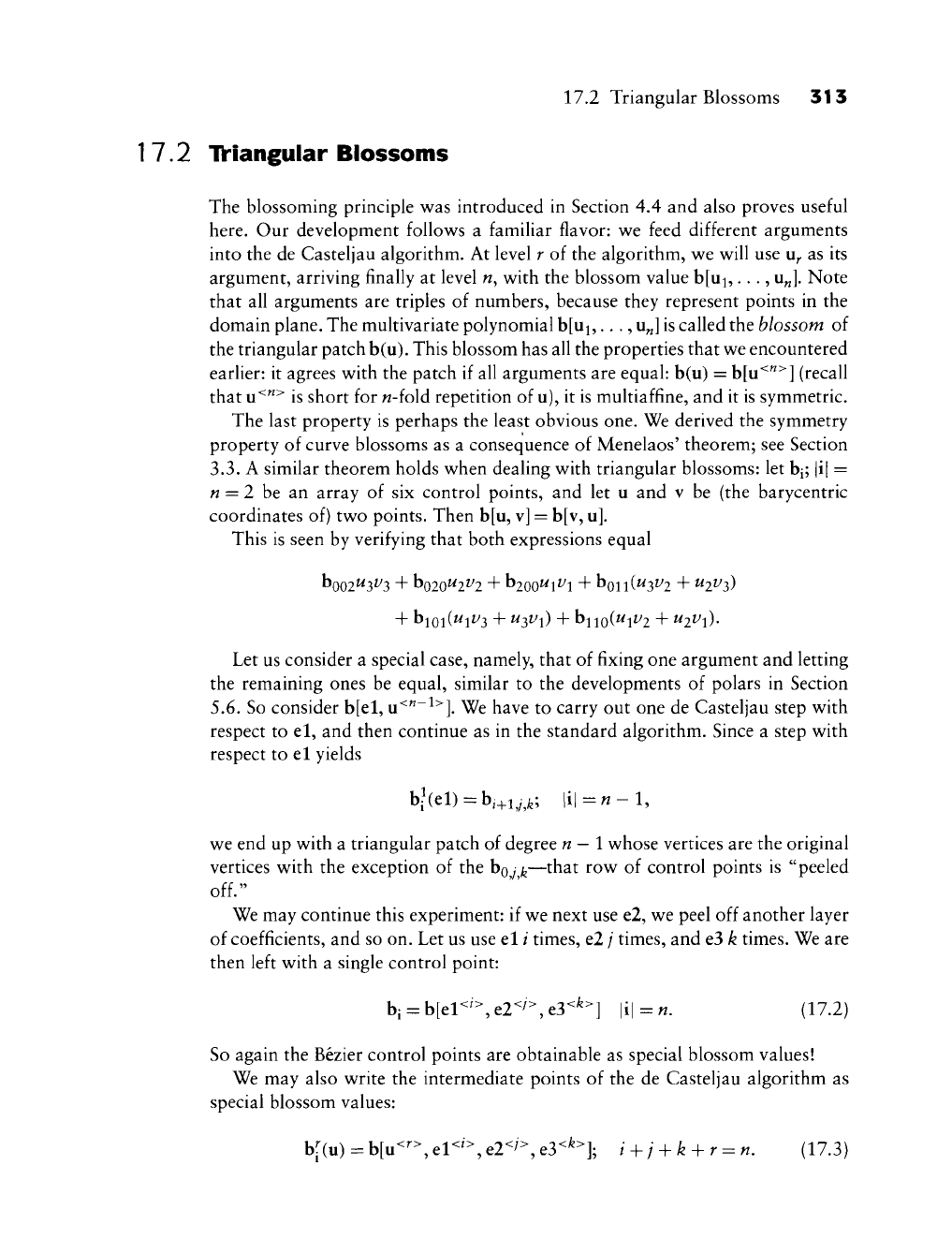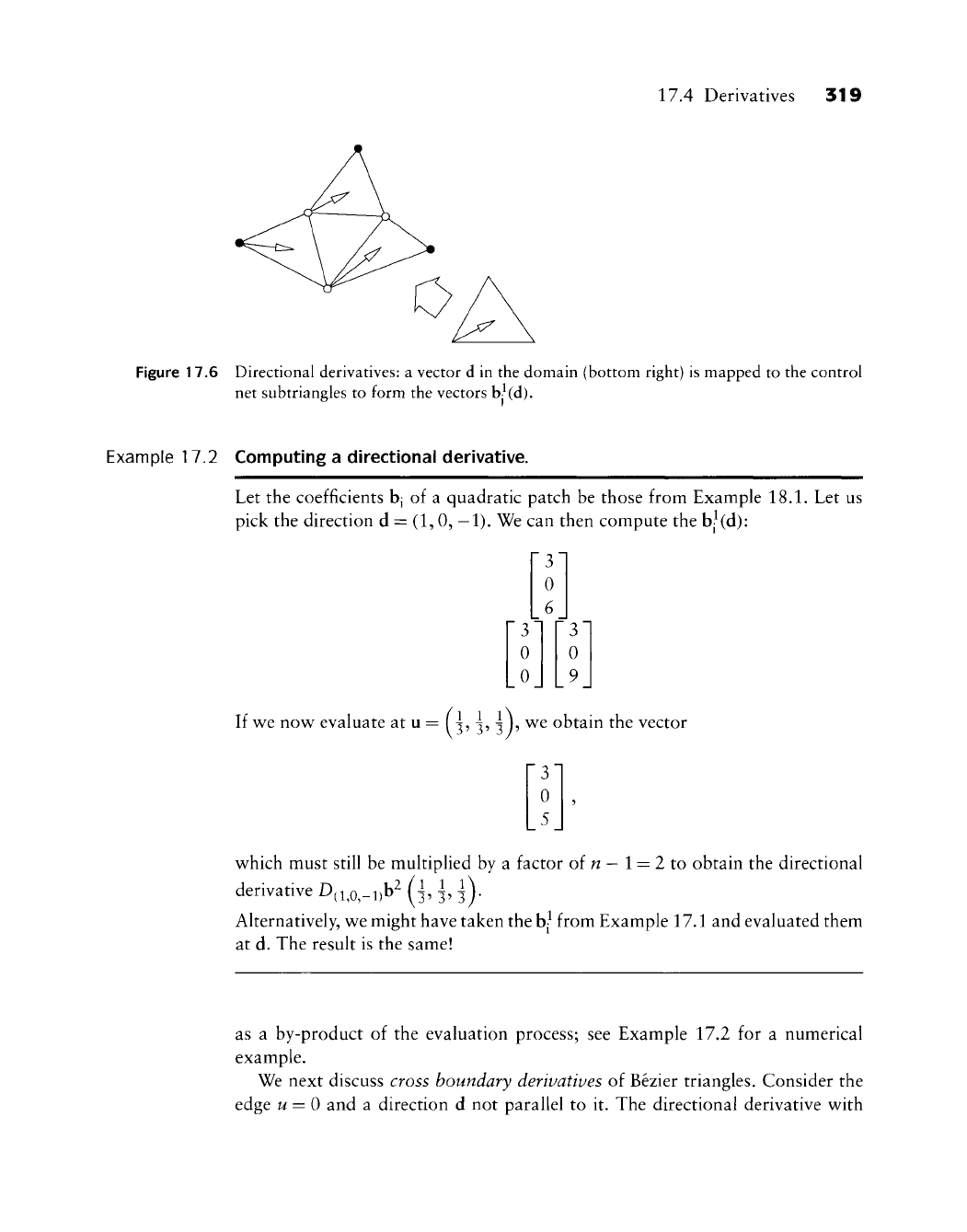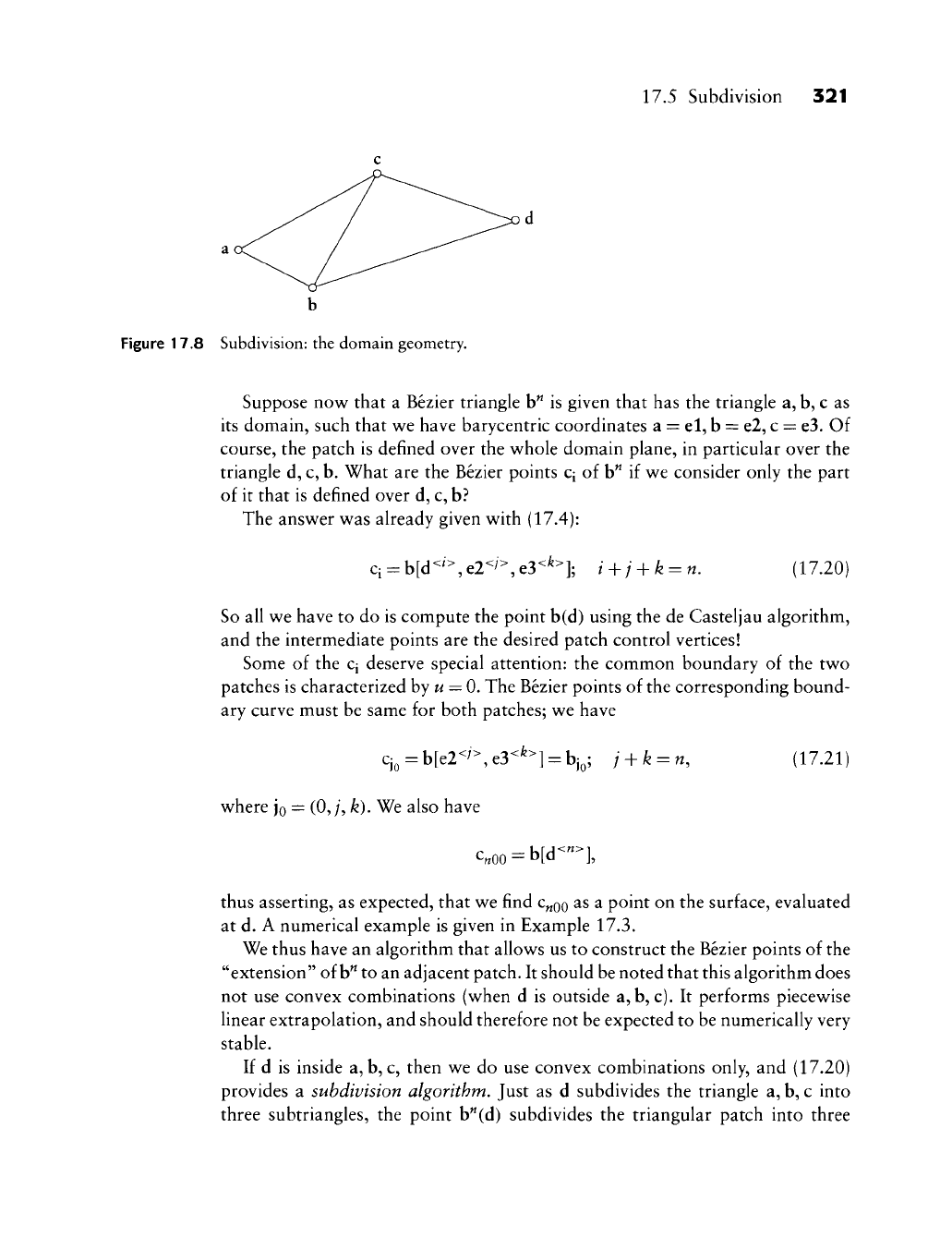Farin G. Curves and Surfaces for CAGD. A Practical Guide
Подождите немного. Документ загружается.


312 Chapter 17 Bezier Triangles
Example 17.1 Computing a point with the de Casteljau algorithm.
Let the coefficients bj of a quadratic patch be given by
0
0
0
3
0
0
6
0
9
and let u = (^, ^, ^). Further, we make the assumption that b3oo = [6, 0, 9]^ is
the image of el, and boao = [0, 6,0]^ is the image of e2.
The de Casteljau steps are as follows: for r = 1, the
b^^
are given by
The result bg is
2
2
7/3
Convex hull property: Guaranteed since for 0 <u^v,w <l, each b[ is a convex
combination of the previous b[~ .
Boundary curves: For a triangular patch, these curves are determined by the
boundary control vertices. For example, a point on the boundary curve
b"(w, 0, w) is generated by
b[(w, 0, w) = uhl~l^ +
^K+e3'
u + w=l,
which is the univariate de Casteljau algorithm for Bezier curves.

17.2 Triangular Blossoms 313
17.2 Triangular Blossoms
The blossoming principle was introduced in Section 4.4 and also proves useful
here.
Our development follows a familiar flavor: we feed different arguments
into the de Casteljau algorithm. At level r of the algorithm, we will use u^ as its
argument, arriving finally at level n, with the blossom value b[ui,...,
u„].
Note
that all arguments are triples of numbers, because they represent points in the
domain plane. The multivariate polynomial b[ui,..., u„] is called the blossom of
the triangular patch b(u). This blossom has all the properties that we encountered
earlier: it agrees with the patch if all arguments are equal: b(u) = b[u^"^] (recall
that u^^^ is short for w-fold repetition of u), it is multiaffine, and it is symmetric.
The last property is perhaps the least obvious one. We derived the symmetry
property of curve blossoms as a consequence of Menelaos' theorem; see Section
3.3.
A similar theorem holds when dealing with triangular blossoms: let bi; |i| =
n = 2 be an array of six control points, and let u and v be (the barycentric
coordinates of) two points. Then b[u, v] = b[v, uj.
This is seen by verifying that both expressions equal
boo2^3^3 + bo2o^2^2 +
^im^\^\
+ boi
1(^31^2
+ ^2^3)
+ bioi(Wil^3 +
Ui^Vi)
+ hxiQ{UiV2 + U2V{).
Let us consider a special case, namely, that of fixing one argument and letting
the remaining ones be equal, similar to the developments of polars in Section
5.6. So consider b[el,
u^"~^^].
We have to carry out one de Casteljau step with
respect to el, and then continue as in the standard algorithm. Since a step with
respect to el yields
biV)=b,+i,;^; |i|=^-l,
we end up with a triangular patch of degree n
— 1
whose vertices are the original
vertices with the exception of the bgy^—that row of control points is "peeled
off."
We may continue this experiment: if we next use e2, we peel off another layer
of coefficients, and so on. Let us use el / times, e2 / times, and e3 k times. We are
then left with a single control point:
bi = b[el<^'^, e2<^'^, e3<^^] |i| = n. (17.2)
So again the Bezier control points are obtainable as special blossom values!
We may also write the intermediate points of the de Casteljau algorithm as
special blossom values:
br(u) = b[u<^^, er^"^, e2<^'^,
e3<^^];
i^j + k^r = n, (17.3)

314 Chapter 17 Bezier Triangles
Figure 17.3 A curve on a surface: a line segment in the domain is mapped to a curve on a triangular
patch.
If we are interested in the control vertices Cj w^ith respect to a triangle with
vertices f
1,
f2, f3, all we have to do is to evaluate the blossom:
q = b[fr^'^, f2<^'^,
£3^^^].
(17.4)
This relationship, without use of the blossoming principle, is discussed by Gold-
man [261] and by Boehm and Farin [81]. See also Seidel
[564].
The triangular analogue to the Leibniz formula (3.22) is as follows:
h[(at + Psr^'n = Yl ('')«')^""'b[r<^>,
s<"-^^].
(17.5)
i=o ^^^
There is an immediate practical ramification of this formula: suppose we are
given two points r and s in the domain. The straight line through them is mapped
to a curve of degree n on the triangular patch. This curve may be written as a
Bezier curve, and its Bezier points are given by
b[r^"^],
b[r^^~^^,
s],...,
b[s^"^].
See Figure 17.3.
If we use three points r, s, t in the domain, we obtain
b[(ar + ps + yt)<^>] = ^ ('''V^>y^b[r<^>,
s<^'>,
t<^>].
(17.6)
liM ^^^
Here, (^) is the generalized binomial coefficient and is defined as
n\
n\
iljlkl
and the summation Xliii=« i^ meant to sum over all triples (/,/, k) with /,/, ^ > 0
and
\i\
=
i~\-
j + k = n.

17.3 Bernstein Polynomials 315
17.5 Bernstein Polynomials
Univariate Bernstein polynomials are the terms of the binomial expansion of
[^ + (1
—
t)f. In the bivariate case, Bernstein polynomials B^ are defined by^
B'liu)
= r UV^^; |i| = n. (17.7)
We define B^{u) = 0 if /,/, ^ < 0 or /,/', k> n. This follows standard convention
for the trinomial coefficients (^). Some of the cubic Bernstein polynomials are
show^n in Figure 17.4.
As a further example, the quartic Bernstein polynomials may be arranged in
the following triangular scheme (corresponding to the control point arrangement
in the de Casteljau algorithm):
Gv^uP' lluv^w 6u^v^
4vw^ lluvw^ llu^vw 4u^v
w^ 4uw^ Gu^u?' 4u^w u^
Bernstein polynomials satisfy the following recursion:
B'liu) = uB\zl^{n) + vBlzl^{xx) +
wB^lzl^ixx)-,
|i| = n. (17.8)
This follows from their definition, as given in (17.7), and the use of the identity
Just as in the curve case, Bernstein polynomials may be used to define a Bezier
triangular patch:
b(u) - Y. MfCu). (17.9)
The proof is a straightforward application of (17.6) and the observation that
u = ut\ + vol +
wt?>.
2 Keep in mind that although
B^(u,
f, w) looks trivariate, it is not, since u-\-v-\-w = l.

316 Chapter 17 Bezier Triangles
Figure 17.4 Bernstein polynomials: the basis functions
^003'
^120 (^^P ^^^) ^^^ ^lll (hottom).
The intermediate points b[ in the de Casteljau algorithm may also be expressed
in terms of Bernstein polynomials:
br(u) = ^bi+jBr(u); \i\=n-r.
(17.10)
We can generalize (17.9) just as we could in the univariate case:
b«(u)= Y^ br(u)Bp''(u); 0<r<n, (17.11)
17.4 Derivatives
When we discussed derivatives for tensor product patches (Section 14.6), we
considered partials because they are easily computed for those surfaces. The
situation is different for triangular patches; the appropriate derivative here is the
directional derivative. Let u^ and
xxi
be two points in the domain. Their difference
d =
U2 —
Ui defines a vector.^ The directional derivative of a surface at x(u) with
respect to d is given by
Ddx(u) = lim — [x(u + d) -
x(u)].
d^o \a\
3 In barycentric coordinates, a point u is characterized hy u-\- v -\-w =
1^
while a vector
d = (J,
e^
f) is characterized hy d-\- e-\-f = 0.

17.4 Derivatives 517
Dax(u)
Figure 17.5 Directional derivatives: a straight line in the domain is mapped to a curve on the patch.
A geometric interpretation: in the domain, draw the straight line through u that
is parallel to d. This straight line will be mapped to a curve on the patch. Its
tangent vector at x(u) is the desired directional derivative; it is shown in Figure
17.5.
Using the proof technique from Section 5.3, we obtain
Ddb(u) = nh[d,
u^"-^^].
(17.12)
Equation (17.12) has two possible interpretations, just as in the curve case. We
may perform one step of the de Casteljau algorithm with respect to the direction
vector d, and n
—
1 more with respect to the position u:
DM^)
= n
J2 W(d)Br^(u). (17.13)
\i\=n-l
Alternatively, we may first carry out «
—
1 de Casteljau steps and then follow up
with one step with respect to d:
Ddb(u) = n(db"^-^ +
eh"^-^
+
/1>^3-l).
(17.14)
We may continue taking derivatives, arriving at:
D^jb(u) = -^h[d<^>,
„<"—].
(17.15)
(n
—
r):
The rth directional derivative at b(u) is therefore found by performing r steps of
the de Casteljau algorithm with respect to d, and then by performing n
—
r more
steps with respect to u. Of course, it is irrelevant in which order we take these
steps (first noted in [188]).
In the same way, we may compute mixed directional derivatives: if dj and 62
art two vectors in the domain, then their mixed directional derivatives are

318 Chapter 17 Bezier Triangles
D'f. b(u) = b[d<^^,d<^>,u<"-^-^>]. (17.16)
This blossom resuh may also be expressed in terms of Bernstein polynomials.
Taking n
—
r steps of the de Casteljau algorithm with respect to u, and then r
more with respect to d gives
D^jb«(u) = -^ T h"-\u)BUd). (17.17)
(n
—
r)l ,T-^ ^ ^
\]\=r
Or we might have taken r steps with respect to d first, and then n
—
r ones with
respect to u. This gives:
D'h"(u)^-^
T hUd)B"-''(u). (17.18)
\\=n-r
Let us now spend some time interpreting our results. First, we note that (17.17)
is the analogue of (5.21) in the univariate case. This sounds surprising at first,
since (17.17) does not contain differences. Recall, however, that some of the
components of d must be negative (since J + ^ +
/^
= 0). Then the B|'(d) yield
positive and negative values. We may therefore view terms involving B-'(d) as
generalized differences. Similarly, (17.18) may be viewed as a generalization of
the univariate (5.24).
For r = 1, the terms b^d) in (17.18) have a simple geometric interpretation:
since bKd) = ^bj_^ei + ^\-\-^i + /bj+e3 ^^d
|j|
=
w —
1, they denote the affine map
of the vector d e E^ to the triangle formed by bj_^ei, bj+e2?
bj+e3-
The directional
derivative of b" is thus a triangular patch whose coefficients are the images of
d on each subtriangle in the control net (see Figure 17.6). For computational
purposes, we would compute the net of the wb^d) and use them as the input for
a de Casteljau algorithm of an (n
—
1)^^ degree Bezier patch.
Similarly, let us set r = 1 in (17.17). Then,
Ddb"(u) = «^bj'-i(u)B;(d)
1)1=1
= «(Jb«,-i + eb^2"' + ^b«3-i).
Since this is true for all directions d
G
E^, it follows that b^^\ ^^a^^
^^3"^
define
the tangent plane at b'^(u). This is the direct generalization of the corresponding
univariate result. In particular, the three vertices bo^„^o?bo,w-i,i?bi^^_i
Q
span the
tangent plane at bo^^^o with analogous results for the remaining two corners.
Again, we see that the de Casteljau algorithm produces derivative information

17.4 Derivatives 319
Figure 17.6 Directional derivatives: a vector d in the domain (bottom right) is mapped to the control
net subtriangles to form the vectors bj^(d).
Example 17.2 Computing a directional derivative.
Let the coefficients bj of a quadratic patch be those from Example 18.1. Let us
pick the direction d =
(1,
0,
—
1).
We can then compute the bj^(d):
[3'
0
0
'3'
0
6
•31
0
9
If we now evaluate at u = ( 3, 3, ^ 1, we obtain the vector
which must still be multiplied by a factor oin
—
l = 2to obtain the directional
derivative D(i^o,-i)b^ (i h l)'
Alternatively, we might have taken the hj from Example 17.1 and evaluated them
at d. The result is the same!
as a by-product of the evaluation process; see Example 17.2 for a numerical
example.
We next discuss cross boundary derivatives of Bezier triangles. Consider the
edge
w
= 0 and a direction d not parallel to it. The directional derivative with

320 Chapter 17 Bezier Triangles
Figure 17.7 Cross boundary derivatives: any first-order cross boundary directional derivative of a
quartic, evaluated along the indicated edge, depends only on the two indicated rows of
Bezier points.
respect to d, evaluated along
w
= 0, is the desired cross boundary derivative. It
is given by
D',h\u)
n\
u=o
{n-r)\
E
(u)
\\Q\=n-r
M=0
(17.19)
where
\Q
= (0,/, k). Since u = (0, v, w) = (0, v,l
—
v), this is a univariate expres-
sion, that is, a Bezier curve in terms of barycentric coordinates. Note that it
depends only on the r + 1 rows of Bezier points closest to the boundary under
consideration. Analogous results hold for the other two boundaries; see Figure
17.7.
This result is the straightforward generalization of the corresponding uni-
variate result. We will use it for the construction of composite surfaces, just as
we did for curves.
17.5 Subdivision
We will later study surfaces that consist of several triangular patches forming
a composite C surface. Now, we start with a surface consisting of just two
triangular patches. Let their domain triangles be defined by points a, b, c, d, as
shown in Figure 17.8. If the common boundary is through b and c, then the
(domain!) point d can be expressed in terms of barycentric coordinates of a, b, c:
d = v^a + Vih + f
3C.

17.5 Subdivision 321
b
Figure 17.8 Subdivision: the domain geometry.
Suppose now that a Bezier triangle b" is given that has the triangle a, b, c as
its domain, such that we have barycentric coordinates a = el, b = e2, c = e3. Of
course, the patch is defined over the whole domain plane, in particular over the
triangle d, c, b. What are the Bezier points Cj of b" if we consider only the part
of it that is defined over d, c, b?
The answer was already given with (17.4):
q = b[d<^^,
e2<^=^,
e3^^^];
i + j + k = n. (17.20)
So all we have to do is compute the point b(d) using the de Casteljau algorithm,
and the intermediate points are the desired patch control vertices!
Some of the Cj deserve special attention: the common boundary of the two
patches is characterized hyu = 0. The Bezier points of the corresponding bound-
ary curve must be same for both patches; we have
Cj„ = b[e2<'>,e3<*>] = bj,; i + k = n, (17.21)
where Jo = (0,/, k). We also have
c„oo =
b[d<">],
thus asserting, as expected, that we find c„oo ^s a point on the surface, evaluated
at d. A numerical example is given in Example 17.3.
We thus have an algorithm that allows us to construct the Bezier points of the
"extension" of
b^
to an adjacent patch. It should be noted that this algorithm does
not use convex combinations (when d is outside a, b, c). It performs piecewise
linear extrapolation, and should therefore not be expected to be numerically very
stable.
If d is inside a, b, c, then we do use convex combinations only, and (17.20)
provides a subdivision algorithm. Just as d subdivides the triangle a, b, c into
three subtriangles, the point b"(d) subdivides the triangular patch into three
